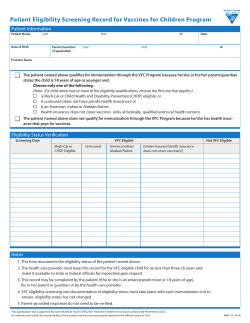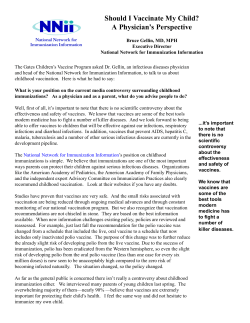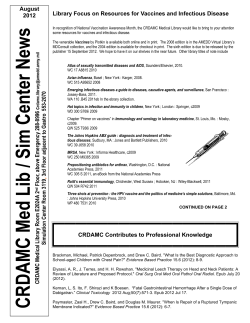
Department of Health Care Services
State of California—Health and Human Services Agency Department of Health Care Services SANDRA SHEWRY Director ARNOLD SCHWARZENEGGER Governor October 3, 2008 CHDP Information Notice: 08-F To: ALL CHILD HEALTH AND DISABILITY PREVENTION (CHDP) PROGRAM DIRECTORS AND DEPUTY DIRECTORS Subject: NEW VACCINES FOR CHILDREN (VFC) VACCINE STORAGE GUIDELINES The purpose of this CHDP Information Notice is to provide you with the VFC letter and Vaccine Storage Guide that were sent to all CHDP (VFC) providers at the end of August this year. The letter includes the new guidelines for vaccine storage units (refrigerators and freezers), explains what type of unit will be required for providers receiving VFC vaccines, and offers a timeline for upgrading existing refrigeration units as needed. Effective July 1, 2009, all enrolled VFC providers will be expected to comply with the new guidelines, with a phased implementation as specified in the letter. As you know, it is of paramount importance that vaccine integrity and stability be maintained. Your assistance to providers in this process of improving vaccine storage and management will help to ensure that only appropriately handled vaccines are administered to the infants, children, and adolescents enrolled in the CHDP program. If you have questions, please contact your Regional Office CHDP Nurse Consultant. Original signed by Harvey Fry for Marian Dalsey, M.D., M.P.H. Marian Dalsey, M.D., M.P.H., Chief Children’s Medical Services Branch Enclosure Children’s Medical Services Branch 1515 K Street, Suite 400, Sacramento, CA 95814, P.O. Box 997413, MS 8100 Sacramento, CA 95899-7413 (916) 327-1400 Internet Address: www.dhcs.ca.gov State of California—Health and Human Services Agency California Department of Public Health MARK B HORTON, MD, MSPH Director ARNOLD SCHWARZENEGGER Governor August 25, 2008 IZB-FY0809-01 TO: California Vaccines for Children Program Providers FROM: Howard Backer, MD, MPH Chief, Immunization Branch SUBJECT: New Vaccine Storage Equipment and Handling Guidelines The Vaccines for Children (VFC) Program is issuing new guidelines for vaccine storage units (refrigerators and freezers). This memorandum explains what type of unit will be required for providers receiving VFC vaccines and it offers a timeline for upgrading existing refrigeration units, as needed. I. Background In recent years, the number of vaccine doses distributed to California Vaccines for Children (VFC) providers has dramatically increased due to new vaccines and expanded immunization recommendations. During 2007, the VFC program distributed over nine million doses of publicly purchased vaccines to public and private providers enrolled in the program, with an average of 2,000 doses received by each provider annually. This number represents a 66% increase from the number of vaccine doses distributed just five years ago. It is estimated that at any given time, the average provider stores tens of thousands of dollars worth of public and private vaccines in their storage units. Vaccine storage and management is a priority for the California Vaccines for Children (VFC) Program and recent vaccine distribution increases have exemplified the need for clear and updated vaccine storage unit guidelines. Correct storage and handling of vaccines maintains the integrity and stability of vaccines administered to patients, prevents inadvertent administration of improperly stored vaccines, and avoids unnecessary vaccine wastage. Vaccine potency and effectiveness is diminished when exposed to temperatures outside the manufacturer’s recommended range. Inactivated liquid vaccines are irreversibly damaged when exposed to freezing temperatures (32º Fahrenheit and below) and live vaccines can be compromised with sustained exposure to elevated temperatures. VFC site visits conducted within the past year have revealed common storage problems that result in damaged or wasted vaccines: Immunization Branch/Division of Communicable Disease Control 850 Marina Bay Parkway, Building P, 2nd Floor, Richmond, CA 94804 (510) 620-3737 Internet Address: www.getimmunizedca.org Storage unit does not provide sufficient usable space to safely store vaccines. Only 30% of the space provided by a typical combination refrigerator-freezer is acceptable for vaccine storage. Vaccines should never be stored as follows: On refrigerator shelves directly beneath air vents (generally the top-shelf) In refrigerator vegetable bins or deli crispers Within 2-3 inches of refrigerator wall surfaces Outside of their original packaging/boxes In dormitory-style refrigerators, Storage unit provides poor temperature control resulting in significant temperature variations (+/- 10 º) of different spots within the storage unit. II. New CA VFC Vaccine Storage Equipment Guidelines The California Vaccines for Children Program has developed new specifications for which types of vaccine storage units are acceptable for the storage of VFC vaccines. Refrigerator-only units, also known as “freezer-less refrigerators” or “free-standing refrigerator only units” will become the required storage units for all refrigerated vaccines distributed through the CA VFC Program. To ensure minimal negative impact on providers, the CA VFC program has decided on the following phased implementation of this new policy. Effective September 1, 2008 all providers newly enrolling in the CA VFC program or providers who experience any vaccine loss due to failure of their current storage unit (regardless of volume) will be expected to comply with the new requirement. Effective July 1, 2009, all enrolled VFC providers will be expected to comply with the new guidelines specified below. These guidelines will be included as part of the 2009 VFC Provider Recertification Agreement. Vaccine storage units must be selected carefully. If your clinic is considering replacement of your current vaccine storage unit prior to July 2009, refer to the guidelines below or check with your local VFC Representative prior to making your purchase. Very High volume providers receiving more than 10,000 vaccine doses per year will be required to store VFC supplied vaccines in a “pharmacy-grade or biologic grade freezer-less refrigerator” and “pharmacy-grade or biologic grade freezeronly” unit. These units are designed for optimum cooling capacity and stable temperature control over the recommended range. High volume providers receiving between 2,000 and 10,000 vaccine doses per year will be required to store VFC supplied vaccines in “refrigerator-only” units and “stand alone freezer” units. Medium volume providers receiving between 500 and 2,000 vaccine doses per year are strongly encouraged to upgrade their vaccine storage units to a “freezerless refrigerator” and a “freezer-only” unit. However, providers will be allowed to keep an existing household refrigerator/freezer combination storage unit as long as it meets all of the following specifications: 1) Provides adequate useable vaccine storage space to store the largest anticipated vaccine supply (e.g. during seasonal peaks, such as back-toschool or flu season) 2) Maintains required vaccine storage temperatures without significant fluctuations year-round 3) Remains frost-free, and free of any visible water or coolant leaks. Cyclic defrost refrigerators (manual defrost freezer combined with a cyclic defrost of refrigerator compartment) are not acceptable. These units, with a visible cooling plate in the back of the refrigerator, often have visible frost formations in the main compartment of the refrigerator which require manual defrost. 4) Must be regularly maintained or serviced and without major required repairs within the past two years 5) Doors seal tightly and close properly 6) Allows for vaccine storage at least 3 inches from internal walls and away from cold air vents. 7) Unit must be used exclusively for the storage of vaccines Low volume providers receiving less than 500 vaccine doses per year will be allowed to have a combination storage unit if it meets all specifications listed above. Medium and Low volume providers with combination storage units that do not adhere to any one of the above listed specifications will be required to purchase separate “refrigerator-only” and “freezer-only” units. For those medium and low volume providers that continue the use of a combination storage unit, please be aware that you are responsible for ensuring that no vaccine is stored in vegetable bins, deli crispers, doors, or shelves located directly underneath air vents. All providers currently using “dorm-style” or household grade “under-the-counter” units are advised that these are not acceptable vaccine storage units as they offer poor temperature control. "Dorm-style" refrigerators are defined as a small combination refrigerator/freezer unit outfitted with a single external door, an evaporator plate (cooling coil) which is usually located inside freezer compartment within the refrigerator, and is void of a temperature alarm device. These units place refrigerated vaccine at a high risk of freezing. Commercial-grade “under-the-counter” units, purposely built for the storage of biologics, may be acceptable for storage of minimal quantities of vaccine. III. Purchasing Your New Equipment: Refrigerator Specifications Refrigerator-only units are quite common and often found in food, beverage and floral industries where products must be stored strictly at +40°F. When purchased through major appliance retailers, the cost of a refrigerator-only unit can range from $400 to $4,000. Biologic or pharmacy grade units which are sold by specialty distributors range in cost from $4,000 to $9,000 dollars. Compared to the dollar amount of VFC vaccines stored by a medium volume provider (an average of $50,000), the purchase of a refrigerator-only unit is a reasonable investment for any practice as it prevents costly vaccine losses for which a practice may be held financially responsible. Optimal Refrigerator Features Unit must maintain uniform temperatures between 35-46°F; preferable units have a preset temperature at 40°F (4°C). Unit must have adequate usable space for the largest anticipated vaccine need Unit must have an automatic defrost cycle Unit should be equipped with a National Institute of Standards and Technology (NIST) certified temperature gauge Unit should offer “Negative pressure self-closing doors” (doors that close automatically) and built-in thermometers are highly desirable Security locks, wire racks, and visible temperature displays are ideal, but not required Unacceptable Refrigerator Features Units with visible cooling plates or open coiling located in the back wall of the unit Separately purchased metal or hard plastic bins because they retain the cold. Vaccine bins must be ventilated (e.g. a mesh-like material or have holes on the sides) Carefully review the refrigeration unit’s specifications to ensure that it meets the above described criteria; talk to a sales representative or obtain expert advice. In addition, always look into maintenance and warranty plans (parts & compressor) offered by the manufacturer/retailer. If you have any questions, please contact your VFC Representative or VFC Customer Service at 1-877-243-8832. Encl: VFC Vaccine Storage Guide, IMM 213 cc: American Academy of Family Physicians American Academy of Pediatrics, California Region IX California Medical Association California Local Health Officers Immunization Branch Field Representatives Immunization Coordinators Gloria Merk, Program Administrator, Child Care Program Office, California Department of Social Services CDPH Immunization Branch Field Representatives Local Health Officers Local Health Department Immunization Coordinators Vanessa Baird, Chief, Medi-Cal Managed Care Division, CDHS Marian Dalsey, M.D., Chief, Children Medical Services Branch, CDHS Michael Farber, M.D., Chief Medical Officer, Medi-Cal Managed Care, CDHS Shabbir Ahmad, DVM, MS, PhD., Acting Chief, Maternal, Child and Adolescent Health/Office of Family Planning Branch, CDPH Villita Lewis, Deputy Director, Benefits and Quality Monitoring, MRMIB Marcia Ehinger, M.D., Medi-Cal Benefits Branch, CDHS Kathy Chance, M.D., Children Medical Services Branch, CDHS Vaccine Storage Guide Stand-alone Freezer and Refrigerator-only Units 3. Proper Management 1. Proper Temperatures Monitor temperatures! Aim for 0º F Freeze MMR, MMRV, and Varicella 5º F or below Don’t let temps get too warm! Refrigerate all other vaccines Aim for 40º F 35°F - 46°F Don’t freeze liquid vaccines! • Use only certified thermometers in accordance with National Institute of Standards and Technology (NIST). If your thermometer uses batteries, replace them every 6 months. Don’t let temps get too warm! • Check and record refrigerator and freezer temperatures twice a day, first thing in the morning and last thing at the close of business. VFC temperature logs must be kept for a period of 3 years. If the temperature is out of range, immediately contact the VFC Program. • Make sure that the door is shut. 2. Proper Set Up Place thermometers in the center of both the refrigerator and freezer. Post a temperature log on each door. Stand-alone freezer • Keep vaccines in original packaging until it is time to use it. DTaP • Keep VFC vaccines separate from privately purchased vaccines. Hib Hep B No food in refrigerator! DTaP MMR MMR No food in freezer! No vaccine in doors! 0º DTaP MMRV MMRV No vaccine in doors! Group vaccines by type. Clearly label the designated space for each vaccine. Varicella Ice Pack PCV Hep A Rota • Designate one fully trained staff member to be the primary vaccine coordinator and at least one person to be back-up. Ensure ongoing training. 40º MPV/MCV Tdap Tdap Call VFC about any problems! HPV If you have any problems with your refrigerator or freezer: Flu Varicella Ice Pack IPV • Have an emergency plan for extended power outages and freezer or refrigerator malfunctions. • Keep the refrigerator and freezer doors shut Varicella Do Not Unplug • Rotate vaccine stock by placing shorter expiration dates in front. Call VFC if you have any vaccine that will expire within 3 months. DTaP DTaP WARNING! Maintain and rotate stock! Refrigerator-only unit Fill space with cold packs. Ice Pack Post “Do Not Unplug” warning signs on electrical outlets and circuit breakers. Plug in only one unit per outlet. California Department of Public Health, Immunization Branch • 850 Marina Bay Parkway, Richmond, CA 94804 Flu No vaccine in drawers! Fill space with water bottles. Flu H2O Flu H2O • Notify the VFC Program WARNING! Do Not Unplug Vaccines for Children Program (877) 243-8832 VFC Field Representative Set UP for Success! IMM-213 (8/08) Vaccine Storage Guide Combination Refrigerator/ Freezer Units 1. Proper Temperatures Refrigerate all other vaccines. Freeze MMR, MMRV, and Varicella. Aim for 0º F Aim for 40º F 5º F or below Don’t let temps get too warm! 35°F - 46°F Don’t freeze liquid vaccines! Don’t let temps get too warm! 2. Proper Set Up Place thermometers in the center of both the refrigerator and freezer. Post a temperature log on the door. 0º MMR Varicella MMRV Ice Pack Keep vaccine spaced 2-3 inches away from walls, floor, and other boxes. Dashed lines show usable space. Mark unusable space. No vaccine in doors! Ice Pack Ice Pack No vaccine near cold air vent! DTaP DTaP Group vaccines by type. Clearly label the designated space for each vaccine. MPV/MCV Post “Do Not Unplug” warning signs on electrical outlets and circuit breakers. Plug in only one unit per outlet. Hib No vaccine in doors! 40º DTaP IPV No food in refrigerator or freezer! Hep A Hep B Flu Tdap Rota HPV WARNING! Do Not Unplug H2O H2O vaccine in drawers! HHNo OOspace HH2O2Owater bottles. 22 Fill with Set UP for Success! 3. Proper Management Monitor temperatures! Maintain and rotate stock! • Use only certified thermometers in accordance with National Institute of Standards and Technology (NIST). If your thermometer uses batteries, replace them every 6 months. • Rotate vaccine stock by placing shorter expiration dates in front. Call VFC if you have any vaccine that will expire within 3 months. • Check and record refrigerator and freezer temperatures twice a day, first thing in the morning and last thing at the close of business. VFC temperature logs must be kept for a period of 3 years. If the temperature is out of range, immediately contact the VFC Program. • Make sure that the door is shut. Monitor capacity–especially during flu season! • Combination units are acceptable for the storage of minimal quantities of vaccine as long as vaccines are always stored properly within usable space. New VFC providers and providers receiving more than 2,000 doses of vaccine annually may not use combination units. Check with your VFC representative for specific criteria. • Inventory vaccine and ensure that there is enough space in refrigerator and freezer before ordering. • Keep vaccines in original packaging until it is time to use it. • Keep VFC vaccines separate from privately purchased vaccines. • Have an emergency plan for extended power outages and freezer or refrigerator malfunctions. • Designate one fully trained staff member to be the primary vaccine coordinator and at least one person to be back-up. Ensure ongoing training. Call VFC about any problems! If you have any problems with your refrigerator or freezer: • Keep the refrigerator and freezer doors shut • Notify the VFC Program Vaccines for Children Program (877) 243-8832 VFC Field Representative California Department of Public Health, Immunization Branch • 850 Marina Bay Parkway, Richmond, CA 94804 IMM-213B (8/08)
© Copyright 2025

















